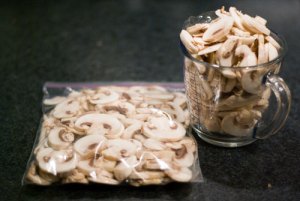
Fondue is our standard meal for special occasions. We have it almost every Christmas and New Year’s and some other times of the year, too. I like it because it’s festive, you get to eat beef tenderloin and for the fact that you can prepare everything in advance. So on the great day, you only have to heat the broth, set the table and everyone is cooking for himself and having fun. Not to mention the romance, coziness and warmth an open fire brings into your house.
And in fact, we prefer the “fondue chinoise” variant, that means cooking thin slices of meat in a broth. As opposed to “fondue bourginonne”, which means cooking the meat in hot oil. That is, of course, tasty like everything that has been fried. But your house will also smell for days as it has been fried. And I’m really not the one to count calories, but food cooked in oil and served with mayo-based sauces simply is too fatty for my taste.

For FONDUE, you’ll need beef tenderloin – and I like to cut it into 5mm-thick slices – a good wine, crispy french bread and lots of different sauces. And of course a rechaud, that means some kind of tripod with an alcohol burner, so you will have a cooking station in the middle of your table. Heat your favorite kind of broth on your stovetop and when it starts simmering, set it on the burner. Everyone around the table picks up one of those large forks and places it with a piece of meat into the broth for as long as he wants. Then you dip it into your favorite sauce an eat it. I like it when every bite you take tastes different.
Here’s a collection of my favorite sauces:
SAUCE CUMBERLAND
1 orange, juice and zest
3/4 cup port
3/4 cup redcurrant jelly
pepper
1 tablespoon mustard powder

For this sauce, you’ll need an untreated or organic orange, as it is about the peel. Peel the orange with a vegetable peeler and try not to get too much of the white stuff. It’s bitter.
Then cut the orange peel into thin strips.

You also want the juice of the orange, it should be around a 3/4 cup. Mix the juice with the peel and let it cook together for a couple of minutes until the peels have softened a bit.

Mix the orange juice with the port. This alone smells incredibly.

Put the jelly into a pot and heat it up to make it more liquid. And yes you can use the pot you used to cook the orange juice without cleaning as it’s going to end up mixed together anyway. Mix the jelly with the orange-port mixture and then season with a healthy dose of pepper and mustard powder. Let it cool completely before serving.
ORANGE SAUCE
1 orange, juice and zest
3/4 cup port
1 cup mayonnaise (best homemade)

Just as with the Cumberland sauce, peel and juice an orange, then cook it for some minutes. Mix with the port and let the juice simmer for several minutes more until it has reduces significantly and looks like syrup. Let that syrup cool and mix it with the mayo.
SALSA GOLF / RUSSIAN DRESSING / COCKTAIL SAUCE
1 cup mayonnaise (best homemade)
1 cup ketchup
1 tablespoon Cognac

This is one of my all-time-favorites. Just the same amount of mayo and ketchup and a bit of Cognac.

Mix it together and you have a sauce that goes with almost everything.
BANANA CURRY DIP
1 large and ripe banana
1/4 cup yogurt
1/2 cup mayonnaise (best homemade)
1 tablespoon honey
1 teaspoon curry powder
salt and pepper

Peel the banana and mash it. You can either leave some chunks or use a stick blender to make a smooth paste.

Mix the banana puree with yoghurt and mayo, and then season with honey and curry powder.

Give it a taste and see if it needs some salt and pepper. I like a lot of pepper.
AIOLI
1 cup mayonnaise (best homemade)
crushed garlic (amount depends on how much you like garlic, I use 1/2 a bulb)
freshly ground pepper

Peel the garlic and crush it. I like to use my garlic press but you can also use pestle and mortar. Mix with the mayo and season with a good bit of salt an pepper.

This is divine. Nothing better than Aioli on meat or just on some bread. Or grilled vegetables.

Here you see all the sauces mentioned above. To help you identify them, from top to bottom:
aioli
banana dip
salsa golf
orange sauce and
Cumberland.
And of course, I eat the tenderloin cooked medium rare, not raw.









































































